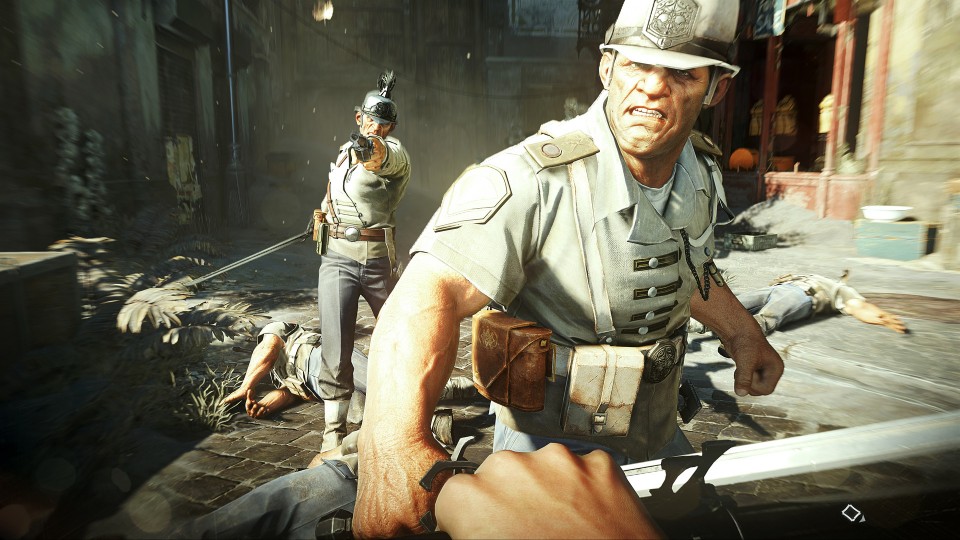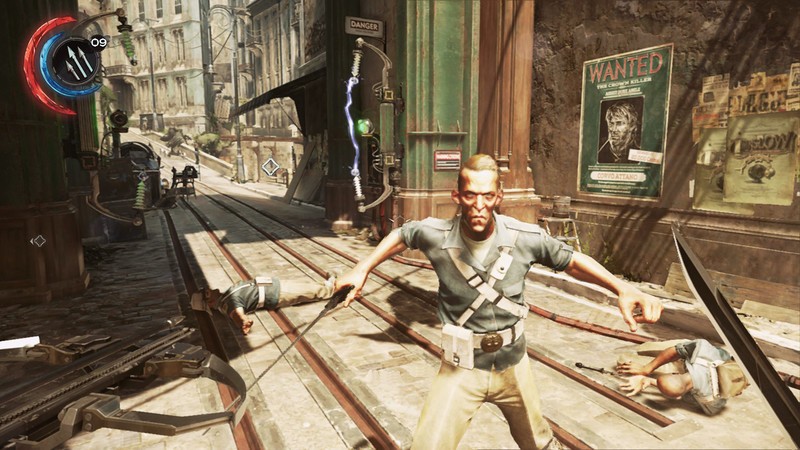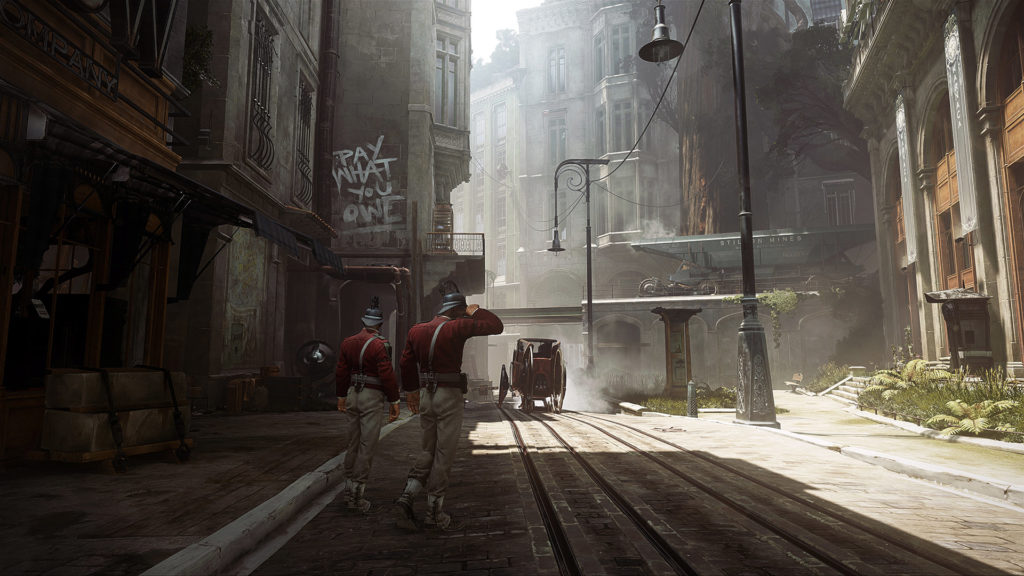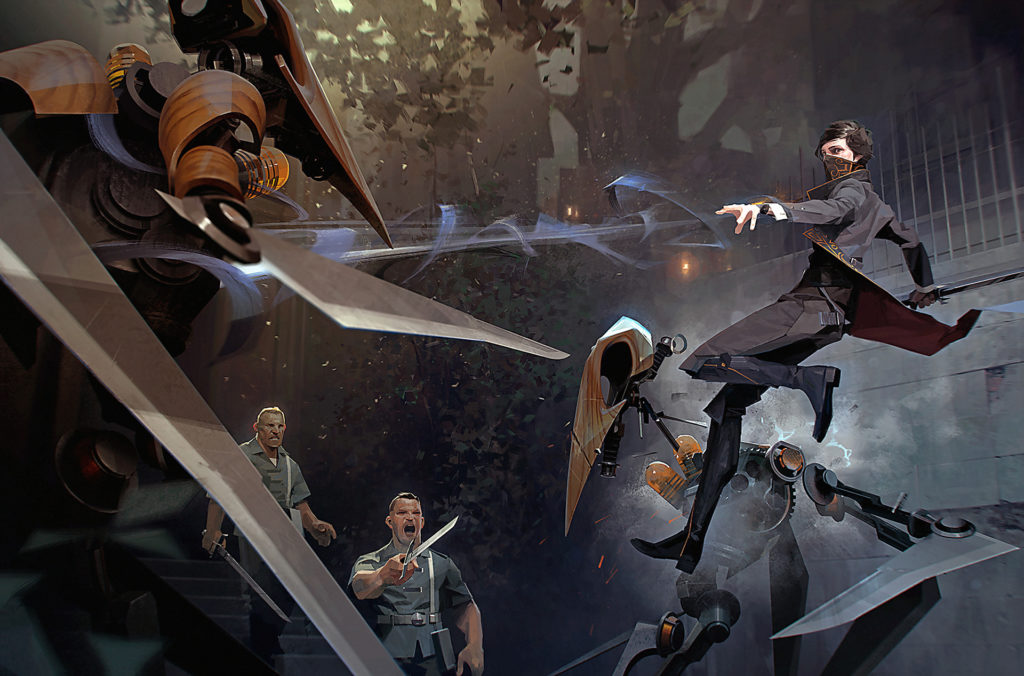After the unexpected hit that was 2012’s Dishonored, French developers Arkane Studios had their work cut out for them crafting a sequel that could do justice to their dark, supernatural steampunk stealther. Four years later, and Dishonored 2 has a lot to prove.
Dishonored 2 takes place 15 years after Empress Jessamine Kaldwin was assassinated, her daughter Emily kidnapped, and Royal Protector Corvo Attano blamed for both acts. Now, the Loyalist Conspiracy has been destroyed, the rat plague that brought Dunwall to its knees has been eliminated, and Emily Kaldwin has taken the throne, with Corvo standing beside her as both Royal Protector and father.
On the fifteenth anniversary of Jessamine’s murder, a foreign dignitary brings a woman with a creepy echoey voice into your throne room and proclaims her the true Empress. Apparently this is all it takes to stage a coup these days, because that’s exactly what happens. The usurper Delilah Copperspoon, a witch marked by the Outsider, removes all of Corvo’s powers before letting you choose to play as Empress or Royal Protector, and freezing the other in stone while you set out to the south to plan your revenge.
Difficulty is largely left up to the player, but is definitely more punishing than the first game. Enemies are more suspicious, search harder and longer, and take unpredictable routes. As a Dishonored veteran, I tried the game out on maximum difficulty settings, and turned them down almost immediately; make sure you save the hardest options for your second or third run, because enemies will go from zero to stabby in half a second, and kill you just as rapidly.

Dishonored sets itself apart other stealth games with the magical powers gifted to you by the Outsider; powers Emily and Corvo have to aid them with stealth or combat. Both have the classic teleport abilities, Corvo with the traditional Blink, Emily with the new Far Reach. Emily’s Mesmerise lets you walk straight past enemies, as does Shadow Walk, while Corvo has Possession to saunter past opponents wearing their comrade’s flesh. Emily can Domino people together for simultaneous kills or chokes, while Corvo can still unleash hordes of rats from the Void. The plague may be over, but the rats are still available to help.
All powers can be upgraded through different trees, allowing you to tailor abilities to your own playstyle; Blink can become offensive, or stop time while aiming, and Far Reach can pull items towards you, allowing you to loot from behind cover, or throw enemies into the air. These powers can be upgraded with Runes scattered through the game world, which are thankfully much more plentiful than in Dishonored. Bone charms allow for more minor, permanent bonuses, and both can now be crafted using whalebone and other items, again letting you “play your own way.”

Dishonored 2 is is gorgeous, and the new Void engine is doing a great job. You know it’s iD tech at work, but Arkane have modified it so heavily that you wouldn’t recognise that it’s basically the same engine that ran DOOM. The evolution of Dishonored’s unique art style is also very apparent, with several key elements having been given a makeover. The architecture and feel of Karnaca is truly unique from anything in the first game, with a genuine Mediterranean feel. Never is this more apparent than in the Void. The sea of white and floating platforms from the first game was cool and all, but the new Void is a dark, howling abyss, all jagged edges and emptiness. It finally feels like what the in-game lore describes it as; a hole at the centre of the universe, and the end of all things.
Everyone’s favourite morally ambiguous deity, The Outsider, has also had a makeover, having changed both actor and appearance since Dishonored. He’s got a lot more personality this time, and is much more involved in the plot development as well, which was a definite plus for me; Dishonored’s lore is second to none, and this is a sequel that really delivers on worldbuilding.
The soundtrack is wonderful, which is no surprise considering the return of the extremely talented Daniel Licht to the project. That man sure knows his atmospheric strings, and makes full use of them in Dunwall and Karnaca alike. In-game sound still carries strangely, though. A holdover from the previous game, it doesn’t matter if the person talking is a floor above or below you, the conversation will still sound like it’s happening an inch from your face. At least it makes eavesdropping easier, so you don’t miss a minute of the amazing patter from Karnaca natives. All voice acting, even from random civilians, is superb, though sadly lacking any lines as quotable as in the original Dishonored. If you’re looking for whiskey and cigars, I’m afraid we won’t be gathering for any of those tonight.
The running commentary from the protagonists adds personality which was sorely lacking in the original installment; it’s very Witcher. Comments also change depending on lethality and chaos level, bringing another level of depth, making you feel like you’re affecting not only the world, but your very self.
Your morality and choices have deep and resounding effects from the very start of the game; I don’t know exactly how many permutations the ending has, but it must be in the dozens. And it’s not just a matter of who lives and who dies; there are good and evil people in all walks of life, and Dishonored 2 addresses that. Using the Heart of your dead lover or mother (don’t make that weird), you can hear the secrets of passersby; one guard might be looking after three kids at home, but another once beat a child until they went blind, and while one servant girl might give half her wages to her aging mother, the next one watched her cousin drown and laughed. This grey approach to morality is impressive, and much more in line with the game’s themes than the more black and white incarnation in the first game.
Level design is sprawling and organic, and simulates an open world where there really isn’t one. After a mission that took me three hours, I sprinted from one end to the other in under a minute, so they’re not really that big, but they’re so much fun to explore that you’ll never really notice.

The missions follow the same core structure as before, but feel totally distinct from the original; even with the gameplay staying the same, Dishonored 2 is very much its own game. Almost every level has some unique mechanic, like clockwork rooms, random dust storms, even time travel, but they’re still a joy to play and never feel like gimmicks.
Lengthwise, my first run as a psychopathic Corvo clocked in at around 22 hours, and my second with invisible pacifist Emily is currently sitting on 10; Low Chaos is definitely a slower route. But replayability is the key to truly seeing Dishonored 2, and with levels and themes shifting along with your playstyle, there’s enough variety here to keep players entertained for quite a while. I definitely encourage players to try out both characters and varying approaches, because it becomes a completely different experience.

I have criticisms, sure, but they’re almost all inconsequential. The pause menu is ridiculously laggy, with sometimes up to two full seconds between button press and menu appearing, and loading can also be infuriatingly slow on PS4. The Void engine struggles at times with the ambitious intentions Arkane had for it, and ironically this happens most often in the Void, with my machine becoming alarmingly loud during some scripted scenes. I had a couple of framerate drops, but they were rare, and some minor light and shadow issues popped up fairly consistently. One particular bug scared the hell out of me, where bodies would randomly stand up and pose with their arms out like they’re preparing for an Olympic floor routine. None of this is game breaking or even that annoying, but it certainly didn’t help my nerves during tense stealth sections.
In 32 hours, I’ve experienced two crashes, one of those a full system crash. But while worrying, they did not hinder my enjoyment of the game one iota, and I never experienced a glitch that made me consider for a second walking away from the the game.

In the end, I love this game. While it’s a slow starter plotwise, Dishonored 2 builds up wonderfully to a satisfying conclusion, with plenty of memorable challenges along the way. But more than anything else, it’s fun. It’s a gorgeous, deep, enjoyable piece of work, and I highly recommend it if you like stealth, exploration, or cool steampunk Portugal. See you in the Void.